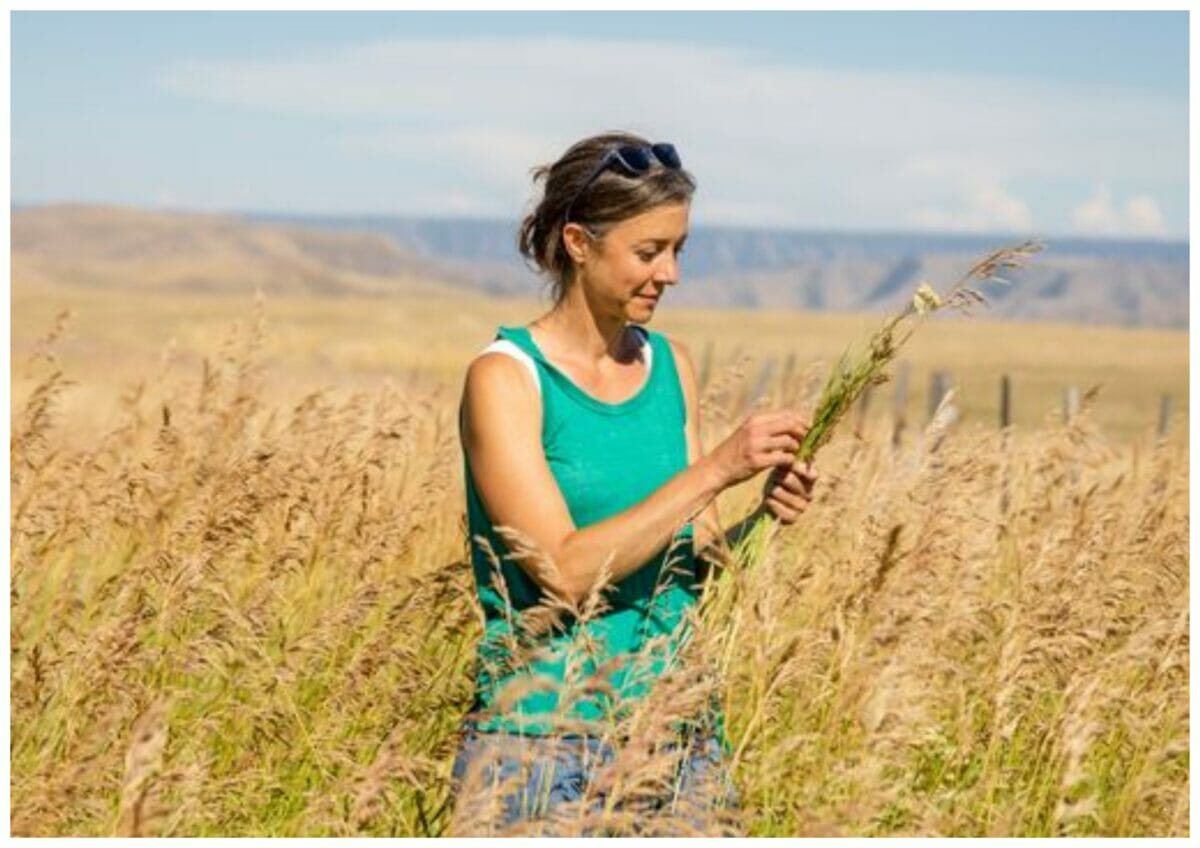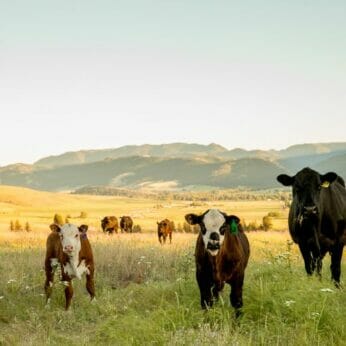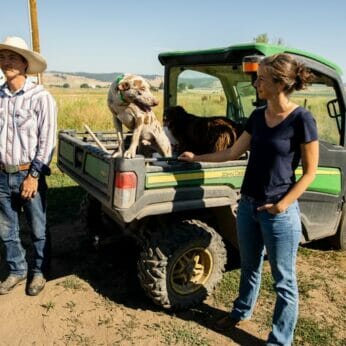Meet the 4th Generation Rancher Driving a Regenerative Cattle Collective Forward
Twenty years after returning to her family’s ranch, Cory Carman is leading a collective on a mission for better steer and soil.
Meet the 4th Generation Rancher Driving a Regenerative Cattle Collective Forward
Twenty years after returning to her family’s ranch, Cory Carman is leading a collective on a mission for better steer and soil.

courtesy of Carman Ranch.
For Cory Carman, choosing to raise cattle outside of the feedlot system always seemed intuitive. Upon leaving her family farm to study agriculture at Stanford, she took up a work-study program investigating the economic viability of grass-fed beef.
“It was the first time I’d been around a lot of people that really thought eating beef was awful. And it was the first time I’d been around feedlots before,” she says. “Driving the I-5 between LA and San Francisco, I was like, ‘Oh, this is what people think cattle ranching is.’”
Carman didn’t intend to stay on the ranch on which she grew up. Yet when she returned to the farm in Wallowa, Oregon, in 2003, only her grandmother and uncle were left running the operation. She witnessed how difficult it was for them to work the ranch alone. It quickly became clear: There was no place like home to try raising better beef.
“It seem[ed] so simple, 20 years ago,” she says. “‘We just don’t send them to the feedlot.’”
Her “simple” idea was well timed. The same year that Carman returned to her family farm, a case of bovine spongiform encephalopathy (BSE), also known as mad cow disease, was detected in the US. It was the first of only six such cases in the US, but it sparked safety concerns for consumers who were aware of the UK’s massive outbreak of BSE, with human casualties, in the 1990s. For some, the notion of eating beef from cattle raised on wide open land and all-grass diets took on the perception as a safer, more natural choice. And, one that must also be more sustainable.
Four years later, in 2007, the USDA issued a label standard for grass-fed beef. Consumer interest continued to grow. Between 2012 and 2016, sales of grass-fed beef rose by $255 million, with nearly 3,900 producers across the U.S.—including Carman— identifying as grass-fed beef ranchers.
In 2016, the government standard for grass-fed labeling was dropped, yet demand for the segment has not cooled. U.S. grass-fed beef sales reached $776 million in 2022. But the optimism over grass-fed beef as a remedy for sustainability issues in the beef industry hasn’t necessarily kept pace.

When it comes to sustainability, the conversation about grass-fed versus feedlot-finished beef is complicated. The use of land for grazing cattle, as opposed to more productive crops or carbon-sequestering forests and prairies, is a key issue for critics of the beef industry—and grass-fed cows require more land than those finished in grain in feedlots. And for grass-fed and finished cows specifically, a longer lifespan equates to more total methane, a powerful greenhouse gas, released into the atmosphere.
But emissions may not tell the whole story. Proponents point out that livestock brought up on ranges filled with native, carbon-sequestering plants can prevent erosion, improve soil health and significantly reduce the total environmental footprint of a ranching operation.
In 2007, an agent from Oregon’s Natural Resources Conservation Service began discussing regenerative soil management with Cory Carman. As she tells it, “He started saying things like, ‘Soil health is the future of everything.’”
Heeding those words, a neighboring farmer began testing various new cover crops. Carman saw how deep the benefits could go. Not only were the long roots of these native grasses and herbs capable of carbon capture and nutrient retention, they were also a foraged food source for her livestock.

As Carman Ranch the brand built a following on dedicated grass-fed principles, Carman the farmer began to consider how those lessons in soil management and regenerative agriculture could be scaled up to make a meaningful impact.
“There’s so little that is durable on a single operation,” she says. “Without a market to support better practices, without a community to support innovation and moving the needle, it’s hard to make anything that we do as individuals very durable.”
Carman began collaborating with another fourth-generation family farmer. The two women sold their grass-fed products to New Seasons Market in Portland as well as offering direct delivery and pickup points for customers.
“I really started to see the power of building a network to support a supply chain,” she says.
Eager to develop a new organizational structure that addresses the challenges of the beef supply chain and centers soil health, Carman recruited another group that was also selling grass-fed beef to New Seasons Market. Along with her initial partner, seven more producers from across Montana, Oregon and Washington joined the Carman Ranch collective. Each was already committed to shared principles of conservation and holistic range management.
Carman says of the collective: “It’s our experimental example of the type of groups that could emerge to help further regenerative practices.”

The Carman Ranch collective now spans 220,000 acres and has been certified as “Tier 3” under the Regenified framework. Regenified is a regenerative agriculture certification program, which creates quantifiable testing protocols and measurements for farmers looking to verify their practices to consumers.
Under this tier, 40 percent to 60 percent of the land base within Carman Ranch farms operates under regenerative principles. The testing methods relate to how and what a herd is fed, crop and herd rotation, tillage frequency and other soil health standards.
In addition to aligning data with ranching experience on the ground, the Regenified certification has also pushed Carman and her partners to experiment further. Members have trialed techniques such as seaweed inclusion diets, for example.
On her family ranch, Carman reports using a high-precision methane measuring system called GreenLock. The system captures accurate data on the amount of greenhouse gases produced by her herd, which allows Carman to set viable goals for methane reduction that can be achieved through strategies such as altering feed.
As Regenified audits continue, Carman aims to see more of the collective’s acreage—and herds—meet the rigorous soil health standards of the program and the Carman Ranch vision. She sees it as a new opportunity to challenge the notion that her family industry can’t become more sustainable.
Still, Carman believes the answers are found at a scale just (slightly) bigger than one rancher.
“My theory of change is that regenerative agriculture will be supported through regional networks. And that scale will look like the connectivity of regional networks that are size appropriate, more resilient and more place specific.”
Follow us
This work is licensed under a Creative Commons Attribution-NoDerivatives 4.0 International License.
Want to republish a Modern Farmer story?
We are happy for Modern Farmer stories to be shared, and encourage you to republish our articles for your audience. When doing so, we ask that you follow these guidelines:
Please credit us and our writers
For the author byline, please use “Author Name, Modern Farmer.” At the top of our stories, if on the web, please include this text and link: “This story was originally published by Modern Farmer.”
Please make sure to include a link back to either our home page or the article URL.
At the bottom of the story, please include the following text:
“Modern Farmer is a nonprofit initiative dedicated to raising awareness and catalyzing action at the intersection of food, agriculture, and society. Read more at <link>Modern Farmer</link>.”
Use our widget
We’d like to be able to track our stories, so we ask that if you republish our content, you do so using our widget (located on the left hand side of the article). The HTML code has a built-in tracker that tells us the data and domain where the story was published, as well as view counts.
Check the image requirements
It’s your responsibility to confirm you're licensed to republish images in our articles. Some images, such as those from commercial providers, don't allow their images to be republished without permission or payment. Copyright terms are generally listed in the image caption and attribution. You are welcome to omit our images or substitute with your own. Charts and interactive graphics follow the same rules.
Don’t change too much. Or, ask us first.
Articles must be republished in their entirety. It’s okay to change references to time (“today” to “yesterday”) or location (“Iowa City, IA” to “here”). But please keep everything else the same.
If you feel strongly that a more material edit needs to be made, get in touch with us at [email protected]. We’re happy to discuss it with the original author, but we must have prior approval for changes before publication.
Special cases
Extracts. You may run the first few lines or paragraphs of the article and then say: “Read the full article at Modern Farmer” with a link back to the original article.
Quotes. You may quote authors provided you include a link back to the article URL.
Translations. These require writer approval. To inquire about translation of a Modern Farmer article, contact us at [email protected]
Signed consent / copyright release forms. These are not required, provided you are following these guidelines.
Print. Articles can be republished in print under these same rules, with the exception that you do not need to include the links.
Tag us
When sharing the story on social media, please tag us using the following: - Twitter (@ModFarm) - Facebook (@ModernFarmerMedia) - Instagram (@modfarm)
Use our content respectfully
Modern Farmer is a nonprofit and as such we share our content for free and in good faith in order to reach new audiences. Respectfully,
No selling ads against our stories. It’s okay to put our stories on pages with ads.
Don’t republish our material wholesale, or automatically; you need to select stories to be republished individually.
You have no rights to sell, license, syndicate, or otherwise represent yourself as the authorized owner of our material to any third parties. This means that you cannot actively publish or submit our work for syndication to third party platforms or apps like Apple News or Google News. We understand that publishers cannot fully control when certain third parties automatically summarize or crawl content from publishers’ own sites.
Keep in touch
We want to hear from you if you love Modern Farmer content, have a collaboration idea, or anything else to share. As a nonprofit outlet, we work in service of our community and are always open to comments, feedback, and ideas. Contact us at [email protected].by Brandon Rich, Modern Farmer
September 29, 2023
Modern Farmer Weekly
Solutions Hub
Innovations, ideas and inspiration. Actionable solutions for a resilient food system.
ExploreExplore other topics
Share With Us
We want to hear from Modern Farmer readers who have thoughtful commentary, actionable solutions, or helpful ideas to share.
SubmitNecessary cookies are absolutely essential for the website to function properly. This category only includes cookies that ensures basic functionalities and security features of the website. These cookies do not store any personal information.
Any cookies that may not be particularly necessary for the website to function and are used specifically to collect user personal data via analytics, ads, other embedded contents are termed as non-necessary cookies.